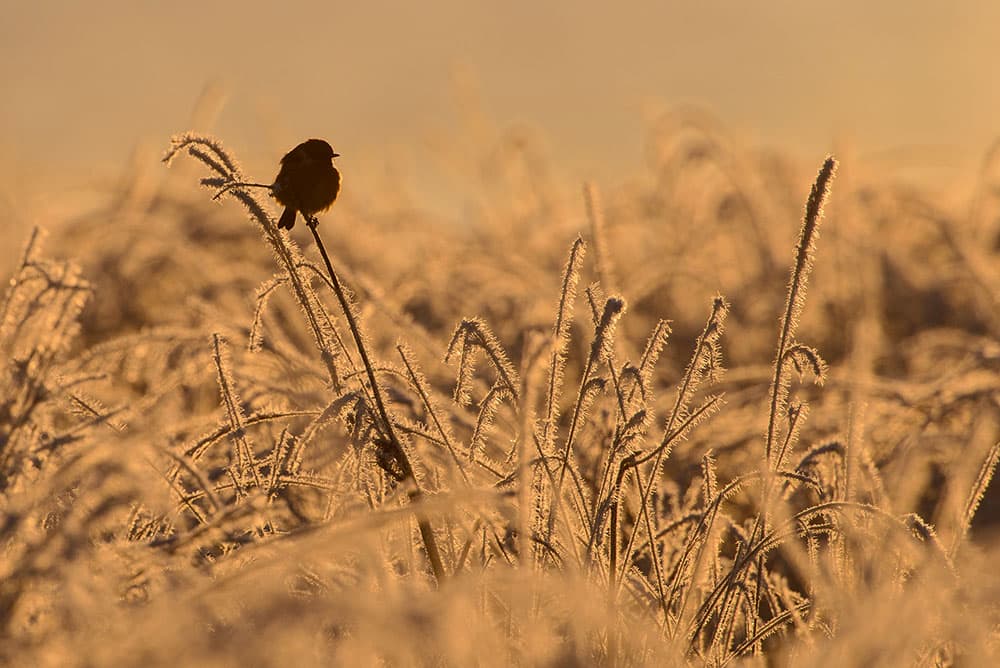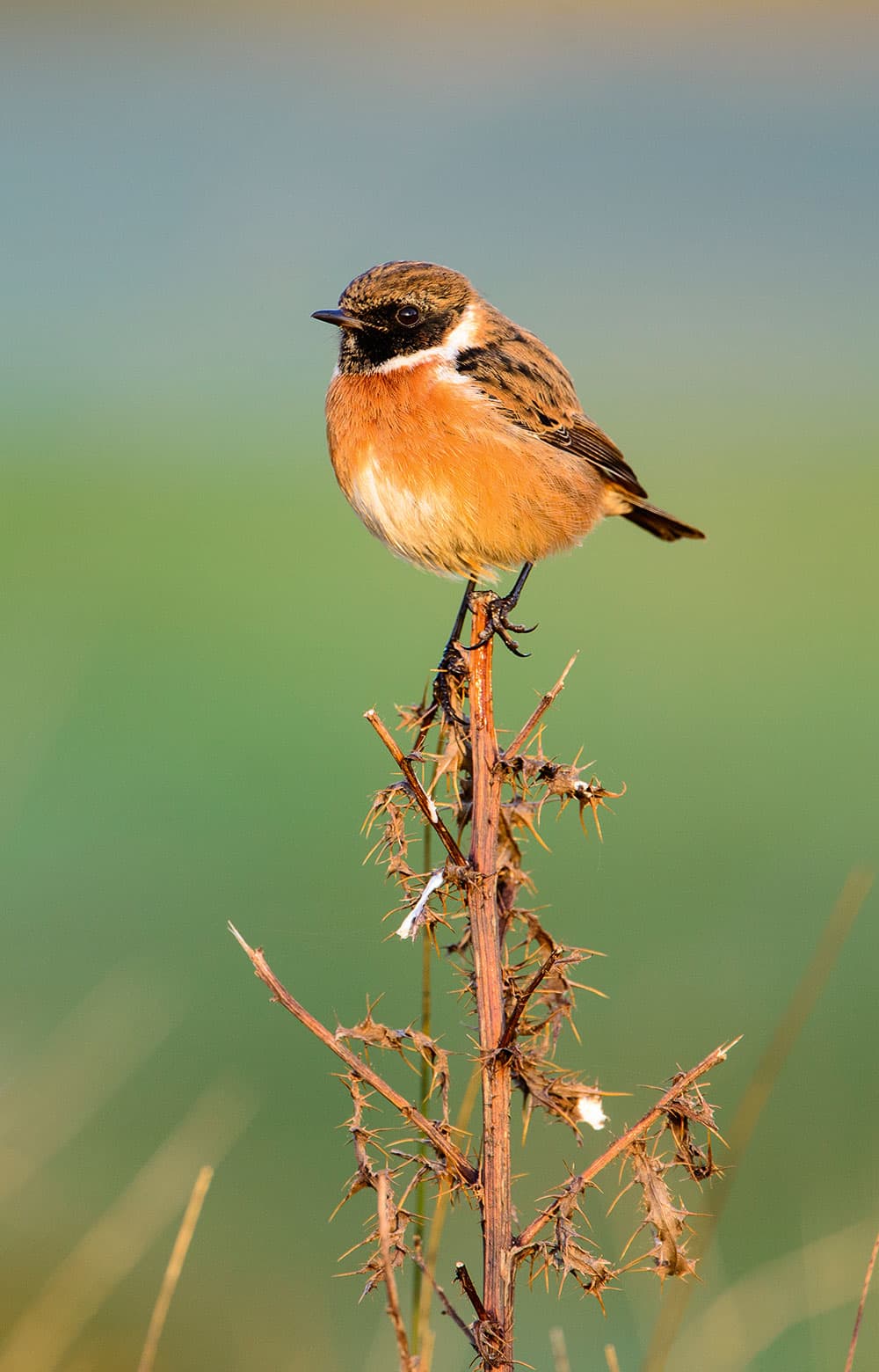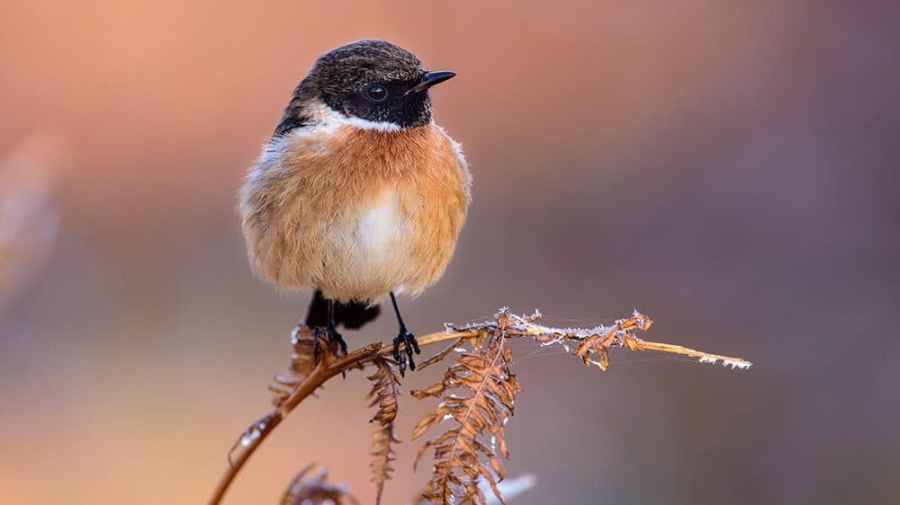
Stonechats are beautiful subjects to capture. This bird’s orange-red breast looks best in the light of early morning or late afternoon. All images Oscar Dewhurst
About Stonechats
Stonechats are robin-sized birds, with an orange-red breast and contrasting dark head, and white neck patches. In winter, they are widely dispersed across the UK in a range of habitats, making them more accessible to photographers than during the breeding season.
- Location Fairly widespread in the UK. In the summer, they can be found breeding on moorland, heathland and sometimes grassland. In winter, some individuals move to the coast.
- Size 11.5-13cm long, so slightly smaller than robins.
- Breeding Stonechats breed in heathland, coastal dunes and rough grassland where there are scattered small shrubs and bramble, gorse or heather, in which a cup-shaped nest is made of grass and moss.
- Diet Primarily invertebrates, but also seeds and fruit such as blackberries.
- Population 59,000 breeding pairs
Stonechats are widespread throughout the UK, and in winter many birds that breed inland on moorland and heathland move out to coastal regions. Their habit of perching on top of vegetation such as bracken and brambles makes them relatively conspicuous and means that clear, unobstructed images can be obtained. They are also very attractive birds, with their striking dark heads, white around their necks and orange-red breasts.
Habitat
In winter, they can be found in a range of habitats, including grassland, moorland, heathland, coastal dunes and wasteland. Have a look at the latest bird sightings online for your county (most counties will have a website for the bird club where you can see latest sightings). Also listen out for their characteristic sharp loud call that sounds similar to two stones being knocked together. However, stonechats are not just a subject for winter photography. In spring and early summer the males have striking black heads while breeding, and around August some of the birds breed in heathland, which turns bright purple and can look stunning in images.

By placing the stonechat small in the frame, you can tell a story of its surroundings
Best time to shoot
One of the good things about photography in winter is that the sun is fairly low all day, so you don’t get the problems associated with harsh sunlight in summer, such as strong shadows and highlights. Having said that, the light near sunrise and sunset is still more appealing. This, combined with higher activity levels around these times, means it’s still worth trying to get out early or late. When the sun is low, it also gives you a chance to use different light angles.
Approach
Stonechats can vary significantly in their tolerance to people. Some remain unconcerned, while others can make life more difficult. They often use the same perches, so if you encounter one that is skittish, watch where they like to perch, then try sitting quietly and waiting nearby. Once you are within photographic range, try to shoot from the same level as the bird, for more intimate images.
[collection name=”small”]
Settings
I always use continuous AF, and single-spot AF to keep focus on the bird’s face. My camera is always set to the fastest frame rate, to increase my chances of capturing the birds when they flick their tail up and down, and flash their wings open. They also regularly leave their perches for a few seconds to catch insects, so there are opportunities for takeoff and landing pictures, although they require very quick reactions.
Lighting
When the sun is behind you, particularly early or late in the day, the warm colours of their breast and back can really pop, and it can also give a catchlight in the eye. However, shooting into the sun can give striking images, such as silhouettes against orange/yellow skies, and stunning rim-lighting around the edge of the bird. If you have the chance, experiment with different light angles and backgrounds to get different effects. As well as different lighting, you can experiment with the size of the bird in the frame, from frame-fillers to including more of the environment. The latter is a good option, for example, in frost or snow.

Setting your camera to single-spot autofocus allows you to keep focus on the bird’s face
Kit list
Binoculars
I carry binoculars wherever I go when I’m doing photography, as they are much lighter and clearer to look through than camera viewfinders, so are invaluable in finding my subject.
Tripod
Stonechats are small, so it can be hard to avoid locking on to the background when handholding. Also, if you are waiting for a bird to land on one of its preferred perches, it is easier to leave the camera on a tripod so you have quick access when it appears.
 Oscar Dewhurst is an award-winning wildlife photographer from London. Currently studying for a research master’s degree in biology, he has already photographed a wide range of subjects, ranging from urban foxes and bitterns, to primates in the Peruvian Amazon. www.oscardewhurst.com.
Oscar Dewhurst is an award-winning wildlife photographer from London. Currently studying for a research master’s degree in biology, he has already photographed a wide range of subjects, ranging from urban foxes and bitterns, to primates in the Peruvian Amazon. www.oscardewhurst.com.







